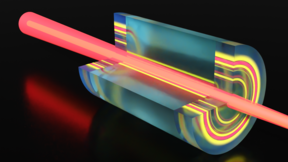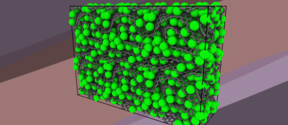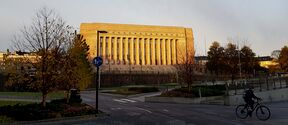Pulled toward the light – measuring how a laser beam compresses water

An international group of researchers coordinated by Professor Nelson Astrath from State University of Maringá (Brazil) has measured the force density laser light exerts within a water column as it passes through. This is the first time the force density exerted by light within matter has been measured; earlier experiments only measured the forces at the interface of different materials, or the net forces exerted on small particles.
Because light is an electromagnetic wave, a laser beam shining through water produces an electrical interaction with the water, known as electrostriction, in which the water is compressed towards the laser beam axis. The researchers compare the phenomenon with squeezing a tube of toothpaste; the paste is squeezed inwards, which also pushes it out along its length, forcing some toothpaste out of the tube.
The same analogy helps explain how the researchers managed to measure the tiny force exerted by light. By closing the ends of the tube of water with glass plates, they effectively put the cap back on the toothpaste tube. Because the compression couldn’t force the water out along the path of the laser, the remaining elastic wave travelling away from the laser beam became the main effect of the light. After measuring the properties of that wave, the researchers could calculate the forces involved.
The experiments, which were carried out in Brazil, had to control for other interactions which could swamp out this effect. ‘For example, lasers also heat water up a tiny amount for a brief moment, causing it to expand,’ said Mauro Baesso and Gabriel Flizikowski from the Universidade Estadual de Maringá. To avoid this, the team had to use ultra-pure water, with nothing in it that would heat up by absorbing more electromagnetic energy than the pure water itself. The wavelength of the laser was also carefully controlled to minimize absorption.
‘The atoms group closer to each other in electrostriction, increasing the density. This constriction is the opposite of the thermal expansion that normally follows electromagnetic absorption at room temperature. Because of this, the compression can only be measured in materials that have very little electromagnetic absorption,’ says Mikko Partanen of Aalto University.
In addition to the experiments, the researchers produced a theoretical model to explain their results. However, further work is needed to properly understand different aspects of the model from the point of view of the special theory of relativity.
The study expands on Nobel Prize winner Arthur Ashkin’s research, which he used to develop optical tweezers for manipulating tiny particles of matter with light. The new research helps us understand how the energy density and optical field of the tweezers affect the matter being manipulated.
‘The research could be applied, for example, to biology or medicine. If optical electrostriction can be used to control the mechanical properties of matter, it could be utilised in optical microelectromechanical systems,’ says Professor Emeritus Jukka Tulkki of Aalto University.
Further information:
Article: Unveiling bulk and surface radiation forces in a dielectric liquid
Mikko Partanen
Postdoctoral researcher
Aalto University
mikko.p.partanen@aalto.fi
Jukka Tulkki
Professor emeritus
Aalto University
jukka.tulkki@aalto.fi
Tel. +358 50 501 4092
Read more news

A paradigm shift: machine learning is transforming research at the atomic scale
Assistant professor Miguel Caro and his research group use and develop machine learning tools to accelerate discoveries from simulation to experiment
Aalto Stoa Archived
Aalto Stoa, the student-driven platform for Otaniemi campus design, has now been completed and archived for future reference.
Elites wield huge influence over deepening polarisation –– now we can tell exactly how much
Researchers used network theory to develop a method for measuring the impact of individuals on societal division.






